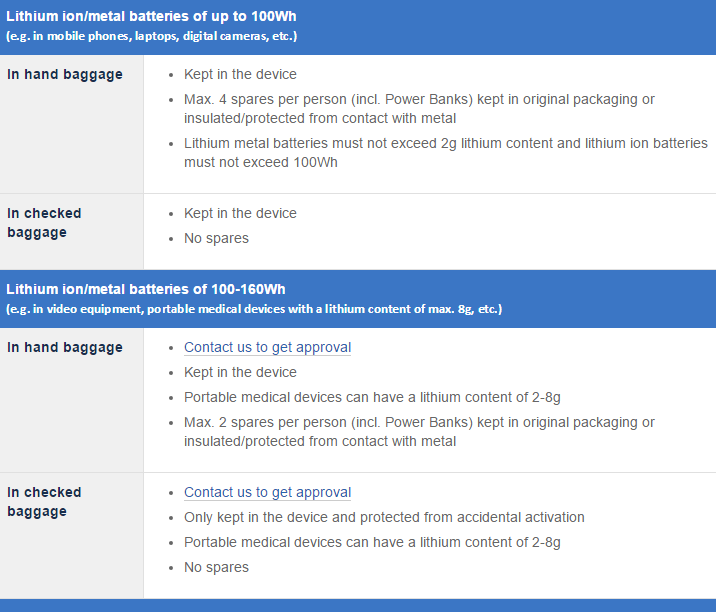 Despite what you may have heard, travelling abroad with a drone isn’t too difficult if you’re prepared. Before we get into the basics it’s important to note that regulations may differ from airline to airline and country to country so make sure you do your homework and contact the appropriate authorities to ensure a hassle-free travel experience.
Despite what you may have heard, travelling abroad with a drone isn’t too difficult if you’re prepared. Before we get into the basics it’s important to note that regulations may differ from airline to airline and country to country so make sure you do your homework and contact the appropriate authorities to ensure a hassle-free travel experience.
Travelling with LiPo Batteries
The one constant you will find when you’re looking to travel with your drone is that LiPo batteries need to be carried on as hand luggage. Due to their volatility and propensity to cause fires when mishandled, it’s easy to see why you aren’t allowed to check them into the hold. First things first, you will need to be upfront with the airline about what you are bringing aboard. You shouldn’t encounter any problems from security if you have clearly stated your possession of the batteries and your intended usage (i.e. powering your drone). If the batteries are under 100Wh, you’re generally allowed up to four spares, however, if you’re carrying more powerful units which are over the 100Wh threshold but below the maximum allowance of 160Wh, you’re likely to be limited to two per person. Please be aware that this is subject to change depending on who you're flying with so always make doubly sure.
More recent batteries, such as those from DJI, should display the watt-hour to make identification simple. If your batteries don’t have this information visible, you can calculate the watt hours by multiplying battery voltage by the Amp hours (Ah).
If the batteries are under 100Wh, you’re generally allowed up to four spares, however, if you’re carrying more powerful units which are over the 100Wh threshold but below the maximum allowance of 160Wh, you’re likely to be limited to two per person. Please be aware that this is subject to change depending on who you're flying with so always make doubly sure.
More recent batteries, such as those from DJI, should display the watt-hour to make identification simple. If your batteries don’t have this information visible, you can calculate the watt hours by multiplying battery voltage by the Amp hours (Ah).
Do Your Homework
It can't be stressed enough that preparation is key when travelling with your drone. Especially if you are using an unfamiliar airline or heading to a country with stricter laws, you are ultimately responsible for checking the facts before departure. Here is an example of the types of restrictions you will encounter - these rules are taken directly from the British Airways site... ...and these are from KLM's section on restricted carry-on items...
...and these are from KLM's section on restricted carry-on items...
 ...and finally EasyJet's guide to hazardous materials...
...and finally EasyJet's guide to hazardous materials...
 ...which should give you some idea of the varied restrictions put in place by airlines.
Always be sure to check the website of the airline you're travelling with and, if there isn't any pertinent information, ensure that you contact them ahead of time to avoid any awkward situations.
...which should give you some idea of the varied restrictions put in place by airlines.
Always be sure to check the website of the airline you're travelling with and, if there isn't any pertinent information, ensure that you contact them ahead of time to avoid any awkward situations.
Top Tips For Transport
When preparing to fly with your batteries the following tips will help to ensure you and your LiPo batteries enjoy an issue-free journey. These suggestions aren’t essential but will go a long way towards making the process as safe as possible.- Cover up the battery connectors with either tape or cling film to avoid electrical arcing or moisture getting into crucial components. If you’re looking for extra protection from moisture you can place your batteries in individual ziplock bags ensuring that all the air is removed before sealing.
- Once you have completed Step 1, place your batteries into a fireproof battery safety bag. The reason behind this is pretty self-evident but it will display that you take the safety of yourself and other passengers very seriously. These bags also come in handy when charging up the batteries for an extra level of safety.
- Now that your LiPos are securely stored it’s time to put them into your carry-on luggage i.e. a backpack. Make sure that they are easily accessible for security checks etc. and you shouldn’t have any problems getting from A to B.
A Closer Look at CAA Regulations
If you're looking to hear the details on LiPos (or lithium metal as they appear in the CAA description) verbatim from the official regulations, you can see the guidelines below:
 For a further insight into the CAA’s procedures and regulations when it comes to lithium batteries, here are a couple of videos that the CAA made for their staff outlining their policy:
For a further insight into the CAA’s procedures and regulations when it comes to lithium batteries, here are a couple of videos that the CAA made for their staff outlining their policy:
Guidance For Crew
Guidance For Cargo and Ramp Personel
...
Keep checking back to Heliguy's Insider blog for more information about getting the most out of your drone, existing regulations and, of course, the latest news from the drone industry.


Leave a comment